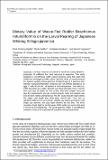Dietary Value of Waste-Fed Rotifer Brachionus rotundiformis on the Larval Rearing of Japanese Whiting Sillago japonica

View/
Publication Date
2020-02-12Author
Ogello, Erick Ochieng
Wullur, Stenley
Yoshitaka, Sakakura
Hagiwara, Atsushi
Metadata
Show full item recordAbstract/
Abstract. Live food resources are useful for larval fish rearing. However, production of sufficient live food resources is expensive. This study employed a cost-effective rotifer culture technique using fish waste diet (FWD) and investigate the effect of the FWD-fed rotifer on larval rearing of the Japanese whiting, Sillago japonica. Fertilized eggs of S. japonica were hatched in polycarbonate tanks containing 100 l of artificial seawater at 10 eggs l-1 with 50 ml min-1 of aeration at room temperature. Two diets (i.e. FWD-fed rotifers and rotifers fed with super fresh Chlorella-V12 as control) were used with 10 rotifers ml-1 for 10 days. Fish were sampled every two days for morphometric and gut content analysis. Fatty acid analysis was done for both rotifers and fish larvae. The fish larvae fed with FWD-rotifers had higher total length than those given control diet. There was no significant difference in survival rate, viability, dry weight, gut content, head length, eye diameter, and body depth between the two diets. The DHA recorded of total lipid for the fish given FWD-rotifer and control fish are3 5.2% and 18.2% respectively. The use of waste-fed rotifers is cost-effective method to enhance the production of larval fish rearing in hatcheries.
